|
 3-Way High Efficiency Speaker
3-Way High Efficiency Speaker
(Lavoce, Dynaudio, Foster 3-way. October-2023)
 LCR MTM 3-Channel Speaker
LCR MTM 3-Channel Speaker
(Three MTM Speakers in One. July-2023)
 Mini7bt - A Minimus 7 Portable Bluetooth Speaker
Mini7bt - A Minimus 7 Portable Bluetooth Speaker
(Minimus 7 and Dayton Audio. Spring-2022)
 2-Way Ribbon Tweeter Speakers
2-Way Ribbon Tweeter Speakers
(Vifa and Pioneer. May-2020)
 Transmission Line Speakers
Transmission Line Speakers
(Aborted attempt at a TL. September-2012)
 Acoustic Research AR-4x Rehab
Acoustic Research AR-4x Rehab
(Rehab of a garage sale find. January-2016)
 Infinity RS-4000 Rehab
Infinity RS-4000 Rehab
(Rehab of a garage sale find. June-2015)
 Polaris
Polaris
(A tall, thin, upwards firing omnidirectional speaker. May-2010)
 Shiva_PR15
Shiva_PR15
(A powered subwoofer using a 12" driver and 15" passive radiator. Jan-2010)
 Can-Less
Can-Less
(A computer speaker; redux. December-2005)
 Can-Can
Can-Can
(A computer speaker in a light canister. Jan-2005)
 Sonosub
Sonosub
(10" vented subwoofer in a cardboard tube, powered by a Parapix amp. May-1999)
 MTM Center Channel Speaker
MTM Center Channel Speaker
(A Madisound design. Nov-1997)
 2-way Surround Speakers
2-way Surround Speakers
(5" woofer and 1" tweeter. July 1997)
 3-piece mini system
3-piece mini system
(6" DVC bass module mated to 4" car speaker. June 1997)
 3-way Vented Floorstanding Speaker
3-way Vented Floorstanding Speaker
(vented 10" woofer, 5" mid and 1" tweeter in a 4
ft tower. Summer 1995)
 NHT1259 Subwoofer
NHT1259 Subwoofer
(A 12" woofer in a sealed architectural pedestal. Winter 1994-95)
 Inexpensive Speaker Stands
Inexpensive Speaker Stands
(Particle board, sand and spray paint. Fall 1994)
 2-way satellite
2-way satellite
(6.5" woofer and 1" tweeter. Summer/Fall 1994)
| Audio Electronics Related Projects |
 900 MHz Audio Receiver
900 MHz Audio Receiver
(Better use for bad headphones. Jan-2008)
 Buster - A Simple Guitar Amp
Buster - A Simple Guitar Amp
(Perfect for the beginner. Jan-2010)
 A PC-based Audio Console
A PC-based Audio Console
(Use a PC to play tunes. Jan-2010)
 LM-12 Amp
LM-12 Amp
(Bridged LM-12 opamps. Aug-2003)
 CeeDeePee
CeeDeePee
(A CD player and FM tuner from spare computer parts. Oct-2002)
 Quad 2000 4-Channel Amp
Quad 2000 4-Channel Amp
(Premade modules by Marantz. May-1998)
 Zen Amp and Bride of Zen Preamp
Zen Amp and Bride of Zen Preamp
(by Nelson Pass. Apr-1997)
 Using Wood in Speakers FAQ
Using Wood in Speakers FAQ
(Work in progress)
 MDF FAQ for speaker builders
MDF FAQ for speaker builders
 Woodworking Tools for the DYIer
Woodworking Tools for the DYIer
(HomeTheaterHiFi.com Oct-1998)
 Some Thoughts on Cabinet Finished for DIY Speakers
Some Thoughts on Cabinet Finished for DIY Speakers
 Large Grills Made Easy
Large Grills Made Easy
 Some Parts Suppliers
Some Parts Suppliers
(Outdated)
 DIY Audio Related URLs
DIY Audio Related URLs
 Veneering Primer
Veneering Primer
(by Keith Lahteine)
 How to get a Black Piano Finish
How to get a Black Piano Finish
(by DYI Loudspeaker List members)
 Sonotube FAQ
Sonotube FAQ
(by Gordon McGill)
 Excerpts from the Bass List
Excerpts from the Bass List
(Oldies but Goodies)
 DIY Loudspeaker List Archives
DIY Loudspeaker List Archives
|
|
LCR MTM 3-Channel Speaker
I didn't need to build the LCR-MTM, but I had the materials and in the end, it seemed like a good idea. LCR refers to Left, Center and Right - the 3 front speakers in a typical home theater setup. MTM is the mid-tweeter-mid driver topology. This speaker contains 3 speakers (the left, center and right), each in a horizontal MTM alignment. It replaces three Cambridge Soundworks speakers that used to sit on the floor by my TV. This speaker reduces the clutter, lifts the sound off the ground and raises the TV's height.

Truth be told, I could have built a shelf above my existing entertainment stand and placed the 3 existing speakers horizontally. They would have fit in the space just as well. But then I wouldn't have had the fun of building my own speaker and using up some materials I had already purchased some time ago.

The "M" is 4 inch shielded mid-woofer from the former MCM Electronics (part number 55-1840). I bought 6 of these a while ago when I saw them used in Avatar Audio's "Pop" speaker. But they sat for years in a box, waiting to be used. The "T" is an Allison Acoustics tulip-shaped tweeter. This is the newer version of the classic tweeter by Roy Allison. I bought four off eBay years ago as well. One had a bad voice coil leaving me with just the right number for this speaker.
Tweeter specs:
- 1 inch convex diaphragm, ferrofluid damped
- 4 ohms
- 87 dB at 1 meter, 1 watt
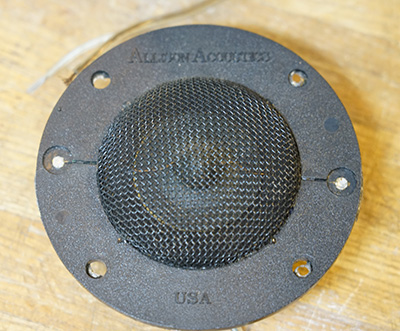
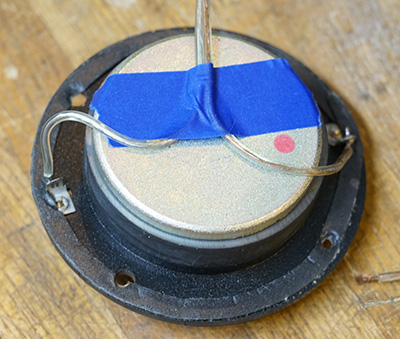
Mid-Woofer specs:
- cone - carbon fiber
- 40W, max 60W
- Impedance 8 ohms>
- Sensitivity 85 +/- 2dB/W/M 2.83V
- Qts 0.522
- Qes 0.753
- Qms 2.233
- Vas 2.1 L
- Sd 0.053 m^2
- Re 6.7 ohms
- Xmax 2mm
- Zo 27.2 ohms
- Cms 0.00053 n/M
- Mms 6.45 g
- Fs 88.0 Hz
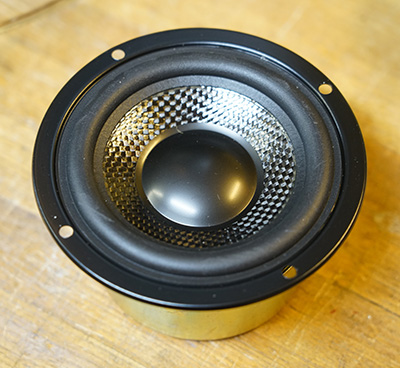
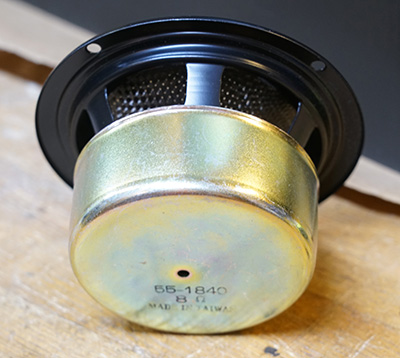
The tweeter crossover is a 2nd order electrical high pass (4 uF cap, 0.25 mH inductor). The woofer crossover is a 2nd order electrical low pass (13.3 uF cap, 0.28 mH inductor) with the woofers wired in parallel. Each crossover module is glued to one of the large wall panels in each section.

The entire speaker measures 45 inches wide, 6 inches high and 11 inches deep (external measurements). It's made from 1/2 inch MDF. The internal space is 14.25 inches wide, 5 inches high and 19 inches deep or 712.5 cubic inches or 0.41 cubic feet, for the left and right side. The center section is just a tad larger at 14.5 inches wide, 5 inches high and 19 inches deep or 725 cubic inches or 0.42 cubic feet. The box tuning is 62Hz with a calculated F3=54 Hz and F10=45Hz. Four inch long, 2 inch diameter PVC ports are rear mounted alongside the terminal cup. The outside is painted with a satin black acrylic paint. The far left and right exterior panels are veneered with 2 layers of rosewood.

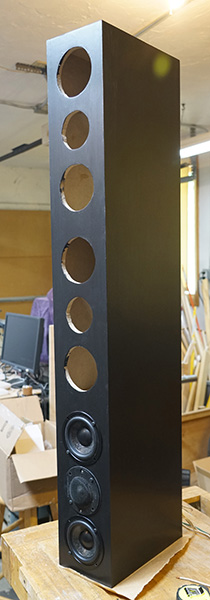


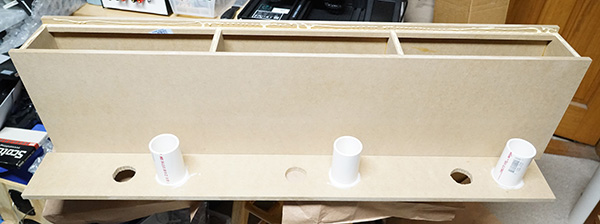
All drivers are surface mounted. The tweeter has a protective metal dome which protrudes about 3/4 inches from the baffle.
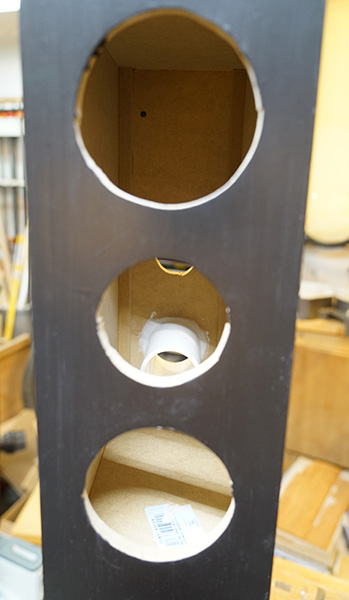
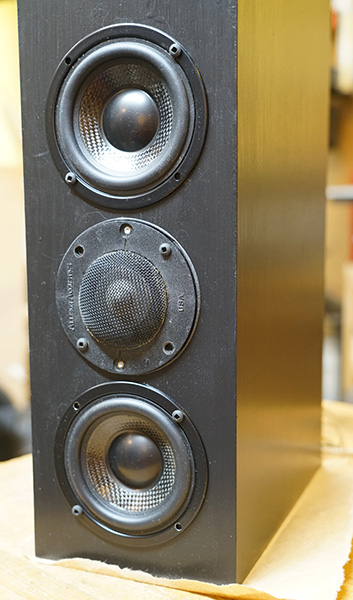
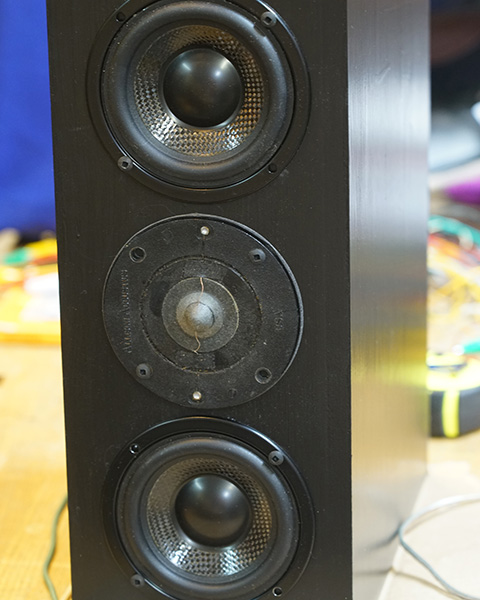
The grill is made from 2 layers of 1/2 inch plywood. Black acoustic fabric covers the front and sides. Four ball and socket connectors hold the grill onto the front baffle at the corners.


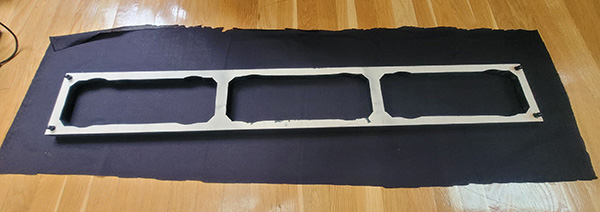



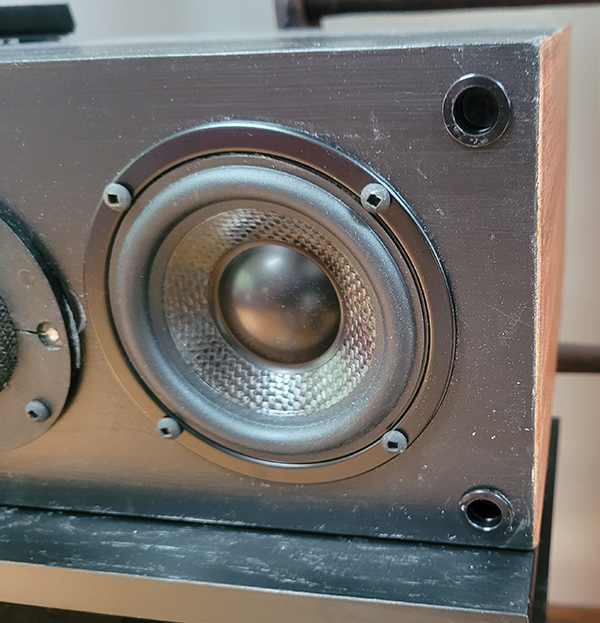
I'm really pleased with the results. The speaker is rock solid (it weighs a ton!) and sounds great. It's more efficient than the previous speakers so I had to re-equalize the subwoofer on the HT receiver. It blends in nicely with the rest of the equipment and we no longer have three little speakers sitting on the floor.
|
|
02-July-2023
Note: The
contents in these pages are provided without any guarantee,
written or implied. Readers are free to use them at their
own risk, for personal use only. No commercial use is allowed
without prior written consent from the author.
|
|
 |